Discover the Power of Chatbots and Transform Your Business! Chatbots are intelligent, AI-driven virtual assistants designed to simplify customer interactions, offer instant responses, and deliver personalized support around the clock. By integrating chatbot technology, businesses can elevate customer satisfaction, foster stronger engagement, and drive significant revenue growth.
Explore the transformative benefits of integrating chatbots into your business. Enjoy cost savings, enhanced efficiency, and the ability to redirect human resources toward high-value tasks. Take your customer service to the next level and unlock the potential of chatbot technology today!

Users in today’s quick-paced world demand quick fixes for their issues. Waiting on hold for a customer service representative or sending an email and waiting for a response is no longer acceptable. Companies are now turning to chatbots to provide instant customer service.
In this article, we will discuss the role of chatbots in customer service and how to implement them effectively.
Chatbots are computer programs designed to simulate human conversation, providing instant customer service to customers.
They use artificial intelligence (AI) and natural language processing (NLP) to understand and respond to customer inquiries in real time. Chatbots can handle a wide range of customer service queries, including product information, billing issues, and technical support.
What are chatbots?
Chatbots are artificial intelligence (AI) programs designed to simulate human-like conversations with users with text or voice interactions. These are commonly used on websites, messaging apps, and social media platforms to provide instant customer support, answer frequently asked questions, and guide users through various tasks.
Chatbots leverage natural language processing (NLP) and machine learning algorithms to understand user queries, learn from interactions, and deliver personalized responses, making them an efficient and cost-effective solution for businesses to enhance customer experience and engagement.
The Benefits of Chatbots in Customer Service
Chatbots offer several benefits to businesses and customers. Here are a few advantages:
● 24/7 Availability: Chatbots are available 24/7, providing instant customer service at any time of the day.
● Increased Efficiency: Chatbots can handle multiple queries simultaneously, reducing the workload of customer service representatives and improving response times.
● Cost-Effective: Chatbots are a cost-effective solution to providing customer service. They don’t need to hire more workers in order to handle a high volume of requests.
● Improved Customer Experience: Chatbots provide instant solutions to customer inquiries, improving the overall customer experience.
How to Implement Chatbots in Customer Service
Implementing chatbots in customer service requires careful planning and execution. Here are some steps to follow:
- Identify the Chatbot’s Purpose
To identify the chatbot’s purpose, businesses should consider the types of inquiries they receive from customers. For example, if customers frequently ask about product information or pricing, the chatbot’s purpose could be to provide instant answers to those queries.
It’s also essential to consider the chatbot’s limitations and capabilities when identifying its purpose. Chatbots can handle a wide range of customer service queries, but they may not be able to provide solutions to complex issues. Therefore, the chatbot’s purpose should focus on handling routine queries and providing basic information to customers.
- Choose a Chatbot Platform:
When it comes to choosing a chatbot platform, there are several options available, each with its own unique features and capabilities. Here are some of the most popular chatbot platforms to consider:
● Dialogflow
● IBM Watson Assistant
● Microsoft Bot Framework
● Amazon Lex
● Botpress
Choosing the right chatbot platform depends on your business needs and budget. Consider the features and capabilities of each platform, as well as the level of customization and control you require. It is also important to choose a platform that integrates well with your existing systems and tools.
By selecting the right chatbot platform, you can create a powerful and effective customer service tool to improve the overall customer experience.
- Design the Chatbot’s Conversation Flow
Designing the chatbot’s conversation flow is a critical step in implementing chatbots in customer service effectively. A well-designed conversation flow ensures that the chatbot can provide relevant and accurate information to customers quickly and efficiently.
Here are some tips for designing an effective chatbot conversation flow:
● Identify the Goal of the Chatbot
● Use Simple and Clear Language
● Use a Natural Language
● Keep the Conversation Flow Short and Direct
● Use Multiple Choice Questions
● Provide Clear and Accurate Responses
● Provide Clear Instructions
● Use Personalization
- Train the Chatbot:
Training a chatbot is an important step in the implementation process. This is where the chatbot learns how to understand and respond to customer inquiries accurately. Here are some steps to follow when training a chatbot:
● Define the Chatbot’s Goals and Objectives: Before training the chatbot, it’s important to define its goals and objectives. This will help you determine the types of conversations it will have with customers and the information it needs to provide.
● Collect Data: Collect data to train the chatbot. This data can be in the form of customer inquiries, chat logs, or transcripts of customer service interactions. This data will teach the chatbot how to understand and respond to customer inquiries.
● Create a Training Dataset: Use the collected data to create a training dataset. This dataset should include examples of customer inquiries and the corresponding responses provided by customer service representatives.
● Choose a Training Algorithm: Choose a machine learning algorithm that is suitable for training the chatbot. There are several algorithms available, including supervised learning, unsupervised learning, and reinforcement learning.
● Train the Chatbot: Use the training dataset and chosen algorithm to train the chatbot. During the training process, the chatbot will learn how to recognize customer inquiries and respond to them accurately.
● Evaluate the Chatbot’s Performance: After training the chatbot, evaluate its performance. Use real customer inquiries to test the chatbot’s responses and make adjustments as necessary.
● Continuously Improve the Chatbot: As the chatbot interacts with more customers, it will continue to learn and improve its responses. Collect feedback from customers and use it to make improvements to the chatbot’s conversation flow and responses.
- Test the Chatbot
Test the chatbot to ensure it provides accurate and relevant information to customers. Use real customer inquiries to test the chatbot’s responses and make adjustments as necessary.
- Deploy the Chatbot: Deploying the chatbot is the final step in implementing it into your customer service strategy. It is essential to ensure that the chatbot is easily accessible to customers and that they know how to use it.
Here are some tips on how to deploy chatbot effectively:
- Website Integration
- Social Media Integration
- Mobile App Integration
- Training
- Customer Feedback
Conclusion:
Chatbots are a powerful tool for providing instant customer service. They offer several benefits to businesses and customers, including increased efficiency, cost-effectiveness, and improved customer experience. By following the steps outlined above, you can effectively implement chatbots in your customer service strategy and provide a seamless experience to your customers.
I hope this article helped you to understand, What Are Chatbots And What Are Their Benefits.
Thank you for reading here, I hope you have liked this article and the article is related to your search. For digital marketing, web designing, SEO, SMM, and more related services contact with DigiPhlox











